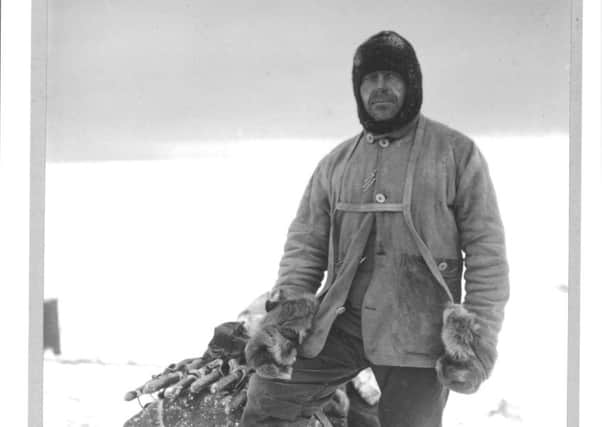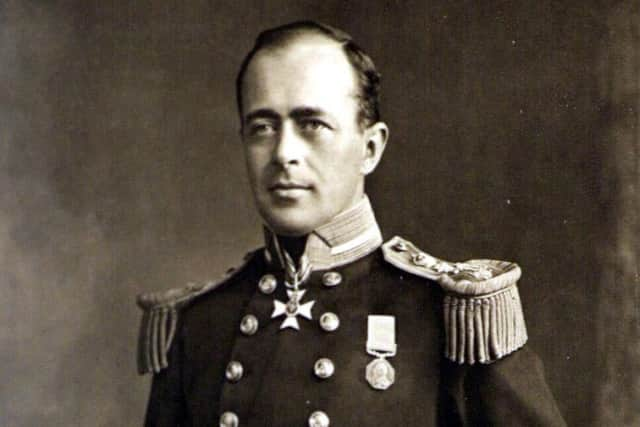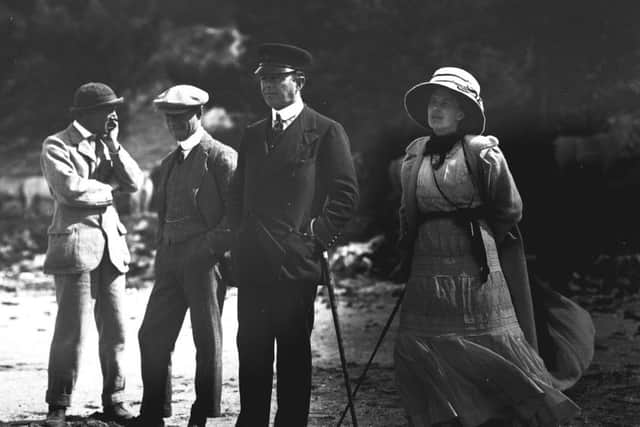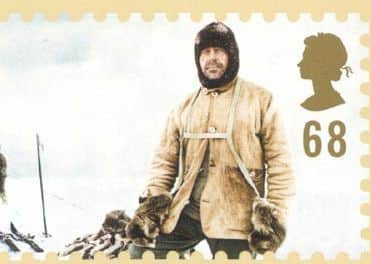Robert Falcon Scott: The great Antarctic explorer


“There never was a man with such a sense of responsibility and duty, and the agony of leaving his job undone, losing the other lives and leaving me uncared for must have been unspeakable.” Kathleen Scott
In some of the old photographs of Robert Falcon Scott, there’s a look of such sadness in his eyes that you almost wonder if he had an inkling about his fate. Or are we, sensitive to the harrowing story of his final weeks, just seeing our own sadness reflected?
Advertisement
Hide AdIn 1887, when the eighteen-year-old midshipman first caught the eye of Sir Clements Markham, the Secretary of the Royal Geographical Society, he had no way of knowing where such distinguished attention was going to lead.


Scott had merely been competing in a sailing race in St Kitts, but Markham was struck by his “intelligence, information, and the charm of his manner.”
Markham was a former naval officer whose adventurous years were now drawing to a close, so his energy as an explorer found an outlet in planning other people’s expeditions. He worshipped the twin icons of the British Empire and the Royal Navy; both, he thought, could be brought together in one great, glorious act, which was the conquest of Antarctica.
He was looking for potential leaders, and he quietly added Scott to his list.
Meanwhile, a burden of care and responsibility was about to descend upon Scott’s young shoulders.


“Truth and right and justice were his gods, and these did not come from any religious sense. They were something within himself. He led a decent human life because he was a decent human being.” Louis Bernacchi, physicist on the Discovery expedition
Advertisement
Hide AdFinancial disaster, shortly followed by his father’s death, left Scott’s family largely dependent on his own meagre income for their subsistence.
Robert - or ‘Con’, as his friends called him - was at an age when grand gestures and sartorial extravagance were more or less expected of ambitious young naval officers, but he had to pare his own spending down to a minimum so that his mother and sisters could keep a rented roof over their heads.
Advertisement
Hide AdAlready acutely self-conscious, he learned to steer clear of expensive parties and withdrew a little further into himself: was this the reason for his air of detachment, misread by others as insecurity and distrust?


“He had no urge towards snow, ice, or that kind of adventure.” Ettie, Scott’s sister
One day in June 1899, Scott was walking down Buckingham Palace Road in London when he was hailed by Sir Clements Markham.
Sir Clements was now President of the RGS, and he was still pursuing his goals of national glory. Would Scott care to become involved with his beloved brainchild, and command a British expedition to the Antarctic?
What a question! To the Victorians, the Antarctic was almost as remote as the moon. It was against the cautious side of his nature, and Scott must have felt torn in many ways. But perhaps he saw a path to riches, or at least a dependable income for life... or maybe the lure of the unknown appealed to his discontented spirit. He might well have seen it as his duty. Whatever his personal reason was, he said yes.


What was known about the Antarctic in 1900?
The answer is next to nothing. Until the early 20th century, human exploration of the Antarctic been largely restricted to whaling ships skirting the fringes of the pack ice. Only a handful of men had set foot on the coast. In 1900 Carsten Borchgrevink, an intrepid Norwegian explorer, overwintered there and reached a latitude of 78°50’S.
Advertisement
Hide AdIn 1893 the Scottish oceanographer and future RSGS President Sir John Murray was partly responsible for reviving interest in the Antarctic, through a lecture to the Royal Geographical Society.
In addition to claiming the South Pole, or, at the very least, a ‘Furthest South’ for king and country, Scott was expected to conduct an extensive programme of scientific experiments and collect natural history specimens that ranged from marine crustaceans to birds’ eggs.
Advertisement
Hide AdIt didn’t matter too much about the preparations. If Markham had a motto, it was probably “youth and eagerness will prevail”.
The Discovery set sail for the Antarctic in 1901. It must have been a baptism of fire, but against the formidable odds, and against many elements of human nature, the ship and her crew survived for two years locked in the Antarctic ice.


When she was finally blasted free with explosives laid by a relief ship, geographical discoveries had been made, a new ‘Furthest South’ of 82°17’ had been attained, and lifelong friendships had been forged. Of the Chief Scientist, a man called Edward Wilson, Scott wrote:
“A first-rate doctor, an excellent artist and a charming messmate, always to the fore and always practical and with the keenest of intellects; I hope and think he will make a great name some day.”
Scott arrived home to a shower of honours and probably more attention than he really wanted; but thankfully, he was now assured of a good income.
Within a few years he was promoted to the position of Naval Assistant to Sir Francis Bridgeman, Second Sea Lord at the Admiralty.
Advertisement
Hide AdIn September 1908 he married Kathleen Bruce, a sculptor and beautiful socialite, in Hampton Court Palace.
Everything had come together: a comfortable home, a lovely wife, a successful career. But there was a darkness haunting Scott’s soul, and it seemed to be embodied - if not fully contained - in the person of Lieutenant Ernest Shackleton.
Advertisement
Hide AdAn Anglo-Irishman with a roving eye and a wickedly persuasive tongue, Shackleton was everything that Scott was not.
He had served on board the Discovery, but after a year Scott had sent him home ‘on medical grounds’; whether this was a reference to Shackleton’s symptoms of scurvy or the fact that he was an increasingly painful thorn in Scott’s side has long been a matter of speculation.
In Shackleton’s mind, the South Pole was already his. As a naval officer, Scott’s sense of duty was inflamed. He had to go back to Antarctica.
On 18th February 1912, Kathleen Scott’s thoughts kept returning to her absent husband. She wrote in her diary:
“I was very taken up with you all evening. I wonder if anything special is happening to you. Something odd happened to the clocks and watches between nine and ten p.m.”
Advertisement
Hide AdThe day before, on their way back to their base camp from the South Pole, Edgar Evans had been the first of Scott’s party to die.
The remaining four men - Lawrence ‘Titus’ Oates, Henry ‘Birdie’ Bowers, Edward Wilson and Scott - pushed onwards, hauling their sledges through snowstorms that were savage even by Antarctic standards.
Advertisement
Hide AdThey were frostbitten, exhausted, undernourished and starving; they were also demoralised.
They had reached the Pole on 17th January only to find an empty tent already pitched there; the Norwegian explorer Roald Amundsen, travelling swiftly with a team of sledge dogs, had beaten them to it by 33 days.
Without speaking it outright, each man could sense how it would end.
Around 17th March, Lawrence Oates, who knew that he would probably lose both his feet even if he survived the trek, muttered something about being gone for ‘some time‘ and crawled out of the tent into the blizzard.
The temperature at that point was -41 Celsius. Just how on Earth these men managed to survive for as long as they did, in an environment which most humans cannot even imagine, is beyond belief.
Nearly two weeks later, as he lay beside his dying comrades, Scott composed letters to his wife, his friends, the wives of his companions, and to the nation as a whole. He still managed, as Ranulph Fiennes has pointed out, to write excellent English in the most appalling conditions. His dearest hope, one which he expressed several times, was that some provision would be made for the widows and mothers left behind.
For himself, he wanted no outpouring of sympathy:
Advertisement
Hide Ad“We took risks, we knew we took them; things have come out against us, and therefore we have no cause for complaint, but bow to the will of Providence, determined still to do our best to the last... Had we lived, I should have had a tale to tell of the hardihood, endurance, and courage of my companions which would have stirred the heart of every Englishman. These rough notes and our dead bodies must tell the tale.”
To his friend, the author J M Barrie, he wrote: “I may not have proved a great explorer, but we have done the greatest march ever made and come very near to great success.”
Advertisement
Hide AdIn 1904, during a lecture which he gave at their meeting rooms in Edinburgh, Robert Falcon Scott was awarded the Livingstone Medal by the Royal Scottish Geographical Society. It was awarded to him ‘for his valuable scientific exploration in the Ross Quadrant, Antarctic region, 1901-04.’
“He cried more easily than any man I have ever known. What pulled Scott through was character, sheer good grain which ran over and under and through his weaker self and clamped it all together.” Apsley Cherry-Garrard
Jo Woolf, is the Royal Scottish Geographical Society’s writer-in-Residence.
